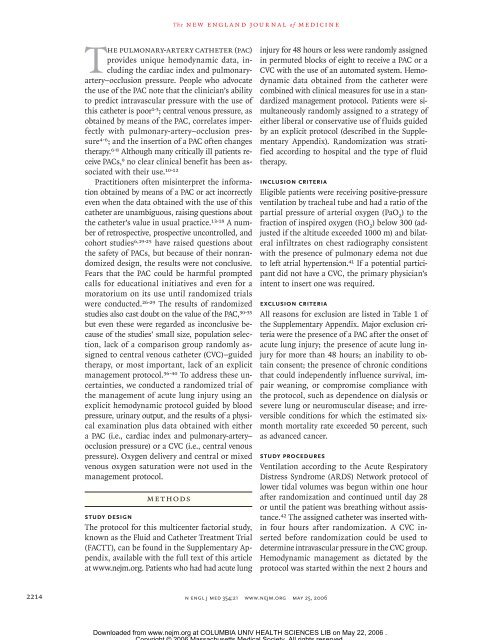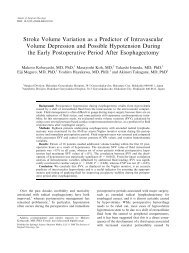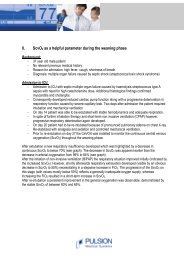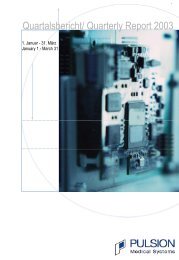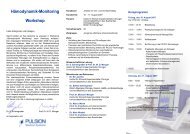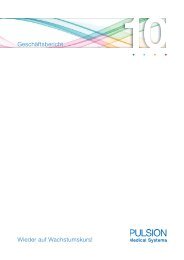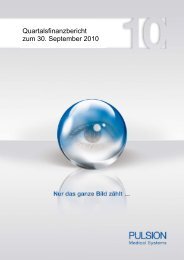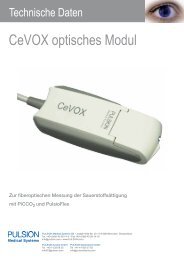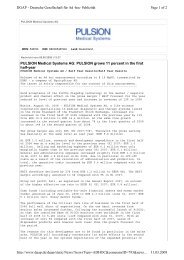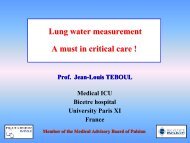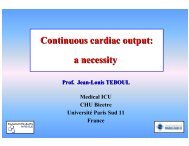The new england journal of medicine - PULSION Medical Systems SE
The new england journal of medicine - PULSION Medical Systems SE
The new england journal of medicine - PULSION Medical Systems SE
Create successful ePaper yourself
Turn your PDF publications into a flip-book with our unique Google optimized e-Paper software.
2214<br />
<strong>The</strong> pulmonary-artery catheter (pac)<br />
provides unique hemodynamic data, including<br />
the cardiac index and pulmonaryartery–occlusion<br />
pressure. People who advocate<br />
the use <strong>of</strong> the PAC note that the clinician’s ability<br />
to predict intravascular pressure with the use <strong>of</strong><br />
this catheter is poor 1-3 ; central venous pressure, as<br />
obtained by means <strong>of</strong> the PAC, correlates imperfectly<br />
with pulmonary-artery–occlusion pressure<br />
4-6 ; and the insertion <strong>of</strong> a PAC <strong>of</strong>ten changes<br />
therapy. 6-8 Although many critically ill patients receive<br />
PACs, 9 no clear clinical benefit has been associated<br />
with their use. 10-12<br />
Practitioners <strong>of</strong>ten misinterpret the information<br />
obtained by means <strong>of</strong> a PAC or act incorrectly<br />
even when the data obtained with the use <strong>of</strong> this<br />
catheter are unambiguous, raising questions about<br />
the catheter’s value in usual practice. 13-18 A number<br />
<strong>of</strong> retrospective, prospective uncontrolled, and<br />
cohort studies 6,19-25 have raised questions about<br />
the safety <strong>of</strong> PACs, but because <strong>of</strong> their nonrandomized<br />
design, the results were not conclusive.<br />
Fears that the PAC could be harmful prompted<br />
calls for educational initiatives and even for a<br />
moratorium on its use until randomized trials<br />
were conducted. 26-29 <strong>The</strong> results <strong>of</strong> randomized<br />
studies also cast doubt on the value <strong>of</strong> the PAC, 30-35<br />
but even these were regarded as inconclusive because<br />
<strong>of</strong> the studies’ small size, population selection,<br />
lack <strong>of</strong> a comparison group randomly assigned<br />
to central venous catheter (CVC)–guided<br />
therapy, or most important, lack <strong>of</strong> an explicit<br />
management protocol. 36-40 To address these uncertainties,<br />
we conducted a randomized trial <strong>of</strong><br />
the management <strong>of</strong> acute lung injury using an<br />
explicit hemodynamic protocol guided by blood<br />
pressure, urinary output, and the results <strong>of</strong> a physical<br />
examination plus data obtained with either<br />
a PAC (i.e., cardiac index and pulmonary-artery–<br />
occlusion pressure) or a CVC (i.e., central venous<br />
pressure). Oxygen delivery and central or mixed<br />
venous oxygen saturation were not used in the<br />
management protocol.<br />
Methods<br />
Study Design<br />
<strong>The</strong> protocol for this multicenter factorial study,<br />
known as the Fluid and Catheter Treatment Trial<br />
(FACTT), can be found in the Supplementary Appendix,<br />
available with the full text <strong>of</strong> this article<br />
at www.nejm.org. Patients who had had acute lung<br />
<strong>The</strong> <strong>new</strong> <strong>england</strong> <strong>journal</strong> <strong>of</strong> <strong>medicine</strong><br />
n engl j med 354;21 www.nejm.org may 25, 2006<br />
injury for 48 hours or less were randomly assigned<br />
in permuted blocks <strong>of</strong> eight to receive a PAC or a<br />
CVC with the use <strong>of</strong> an automated system. Hemodynamic<br />
data obtained from the catheter were<br />
combined with clinical measures for use in a standardized<br />
management protocol. Patients were simultaneously<br />
randomly assigned to a strategy <strong>of</strong><br />
either liberal or conservative use <strong>of</strong> fluids guided<br />
by an explicit protocol (described in the Supplementary<br />
Appendix). Randomization was stratified<br />
according to hospital and the type <strong>of</strong> fluid<br />
therapy.<br />
Inclusion Criteria<br />
Eligible patients were receiving positive-pressure<br />
ventilation by tracheal tube and had a ratio <strong>of</strong> the<br />
partial pressure <strong>of</strong> arterial oxygen (PaO 2 ) to the<br />
fraction <strong>of</strong> inspired oxygen (FIO 2 ) below 300 (adjusted<br />
if the altitude exceeded 1000 m) and bilateral<br />
infiltrates on chest radiography consistent<br />
with the presence <strong>of</strong> pulmonary edema not due<br />
to left atrial hypertension. 41 If a potential participant<br />
did not have a CVC, the primary physician’s<br />
intent to insert one was required.<br />
Exclusion Criteria<br />
All reasons for exclusion are listed in Table 1 <strong>of</strong><br />
the Supplementary Appendix. Major exclusion criteria<br />
were the presence <strong>of</strong> a PAC after the onset <strong>of</strong><br />
acute lung injury; the presence <strong>of</strong> acute lung injury<br />
for more than 48 hours; an inability to obtain<br />
consent; the presence <strong>of</strong> chronic conditions<br />
that could independently influence survival, impair<br />
weaning, or compromise compliance with<br />
the protocol, such as dependence on dialysis or<br />
severe lung or neuromuscular disease; and irreversible<br />
conditions for which the estimated sixmonth<br />
mortality rate exceeded 50 percent, such<br />
as advanced cancer.<br />
Study Procedures<br />
Ventilation according to the Acute Respiratory<br />
Distress Syndrome (ARDS) Network protocol <strong>of</strong><br />
lower tidal volumes was begun within one hour<br />
after randomization and continued until day 28<br />
or until the patient was breathing without assistance.<br />
42 <strong>The</strong> assigned catheter was inserted within<br />
four hours after randomization. A CVC inserted<br />
before randomization could be used to<br />
determine intravascular pressure in the CVC group.<br />
Hemodynamic management as dictated by the<br />
protocol was started within the next 2 hours and<br />
Downloaded from www.nejm.org at COLUMBIA UNIV HEALTH SCIENCES LIB on May 22, 2006 .<br />
Copyright © 2006 Massachusetts <strong>Medical</strong> Society. All rights reserved.


